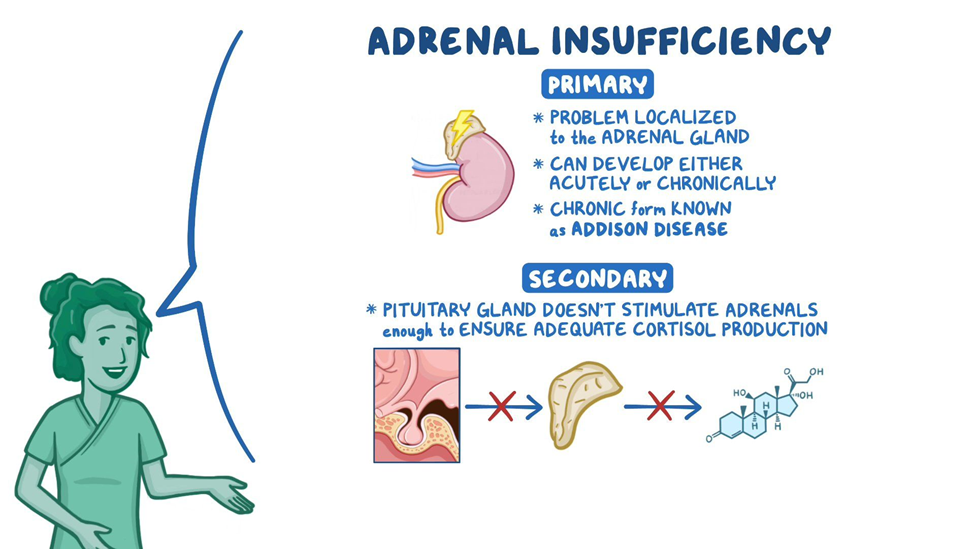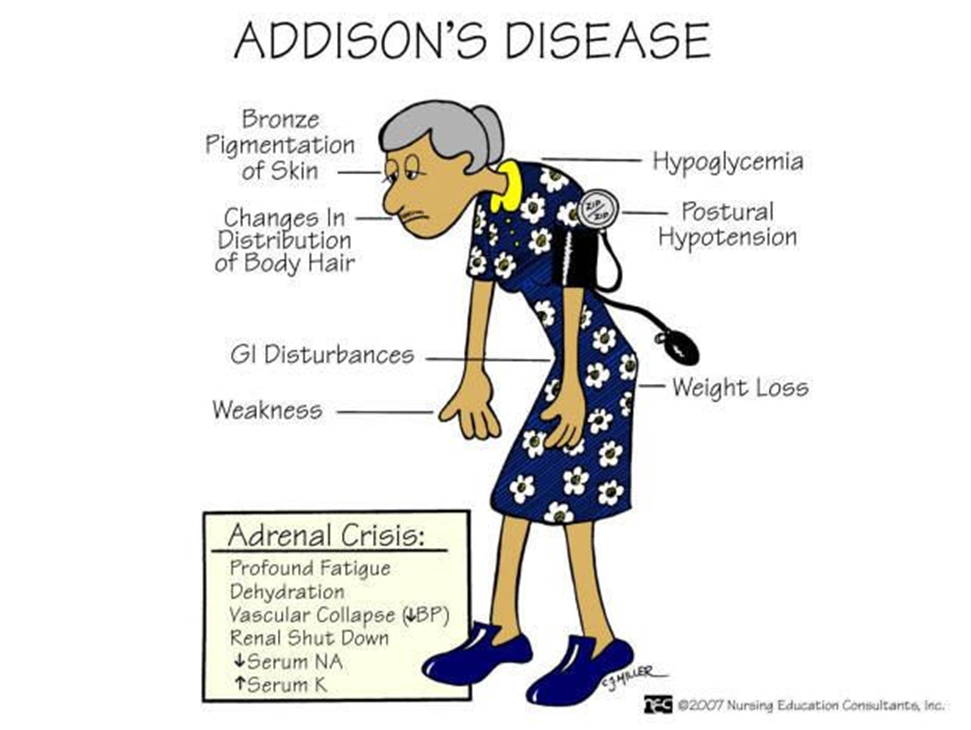The nurse is caring for a patient with Addison's disease who is scheduled for discharge. When teaching the patient about hormone replacement therapy, the nurse should address what topic?
The need to match the daily steroid dose to immediate symptoms
The importance of monitoring liver function
The need for life-long steroid replacement
The possibility of extreme weight loss from use of corticosteroids
The Correct Answer is C
A. The need to match the daily steroid dose to immediate symptoms:
Explanation: Adjusting the steroid dose based on immediate symptoms is not a recommended approach. Patients should follow the prescribed regimen provided by their healthcare provider.
B. The importance of monitoring liver function:
Explanation: While monitoring liver function is important for some medications, it is not the primary focus when teaching about hormone replacement therapy in Addison's disease. The emphasis is on the need for life-long steroid replacement.
C. The need for life-long steroid replacement:
Explanation: Patients with Addison's disease require life-long steroid replacement therapy to compensate for the deficiency in adrenal hormones. It's important for the patient to understand that adherence to the prescribed steroid regimen is essential for maintaining health and preventing adrenal crisis.
D. The possibility extreme weight loss from the use of corticosteroids:
Explanation: While corticosteroids can have various side effects, extreme weight loss is not a typical or desired outcome of steroid therapy for Addison's disease. Weight changes and potential side effects should be discussed, but the emphasis should be on the importance of long-term steroid replacement.

Nursing Test Bank
Naxlex Comprehensive Predictor Exams
Related Questions
Correct Answer is ["B","C","E"]
Explanation
A. Buffalo hump:
Explanation: A buffalo hump is associated with excess cortisol, which is not a typical manifestation of Addison's disease. Instead, patients with Addison's disease may experience weight loss and muscle wasting.
B. Hyponatremia:
Explanation: Correct. Hyponatremia (low sodium levels) can occur in Addison's disease due to the loss of aldosterone, which plays a role in sodium and water balance.
C. Decreased glucose level:
Explanation: Correct. Addison's disease can lead to hypoglycemia (low blood glucose levels) because cortisol, which is important for maintaining blood glucose, is deficient.
D. Weight gain:
Explanation: Weight gain is not a typical manifestation of Addison's disease. Instead, weight loss and muscle wasting may occur.
E. Craving for salt:
Explanation: Correct. Addison's disease can lead to salt craving, as aldosterone deficiency results in increased sodium loss and potassium retention.

Correct Answer is D
Explanation
A. Management of diabetic ketoacidosis:
Diabetic ketoacidosis (DKA) is a severe complication of diabetes characterized by high blood sugar, ketones in the urine, and metabolic acidosis. While it's crucial to understand how to manage DKA, this may be considered more advanced knowledge and may not be categorized as a basic survival skill for someone newly diagnosed with type 1 diabetes.
B. Signs and symptoms of diabetic neuropathy:
Diabetic neuropathy is a long-term complication that involves damage to the nerves due to prolonged high blood sugar levels. While understanding neuropathy is important for long-term health, it may not be the first topic addressed as a basic survival skill for someone newly diagnosed.
C. Effects of surgery and pregnancy on blood sugar levels:
Understanding how surgery and pregnancy can affect blood sugar levels is important for managing diabetes in specific situations. However, this knowledge might be considered more advanced and may not be the initial focus for someone just starting to learn about diabetes self-care.
D. Recognition of hypoglycemia and hyperglycemia:
Recognizing the signs and symptoms of both low and high blood sugar is essential for immediate self-care. This includes understanding when blood sugar is too low (hypoglycemia) and requires prompt treatment, as well as recognizing the symptoms of high blood sugar (hyperglycemia) and knowing how to address them. This knowledge is fundamental for the daily management and well-being of someone with diabetes.
Whether you are a student looking to ace your exams or a practicing nurse seeking to enhance your expertise , our nursing education contents will empower you with the confidence and competence to make a difference in the lives of patients and become a respected leader in the healthcare field.
Visit Naxlex, invest in your future and unlock endless possibilities with our unparalleled nursing education contents today
Report Wrong Answer on the Current Question
Do you disagree with the answer? If yes, what is your expected answer? Explain.
Kindly be descriptive with the issue you are facing.
